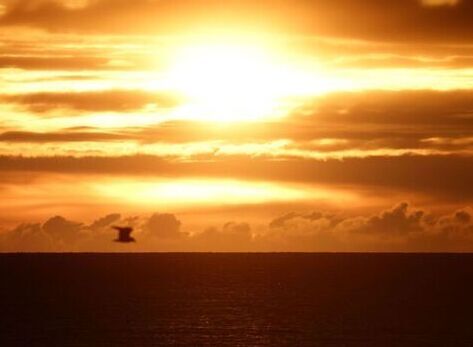The high seas and waves created by Storm Diana pounding the Poolbeg Lighthouse on Dublin’s Great South Wall in November 2018 EAMONN FARRELL/ ROLLINGNEWS.IE
By Michael Behan
Some of us traveling back to Ireland from the United States are delighted to spot a certain feature as we approach Dublin Airport.
They are the red and white chimneys that have become part of our landscape and history. And as such, we Dubliners, especially those of us from Ringsend, can really identify with them.
The chimneys are no longer in operation, although the power station they long served still is. They are, however, protected structures. But how much do we know about them and their history? And what about, more generally, the Poolbeg Peninsula in Ringsend, Dublin?
Well, the chimneys were owned and operated by the Electricity Supply Board generating power to homes in Ireland. They were constructed in the 1960s and 1970s and both stand at just over 207 meters high. The original ESB power station began generating power in 1903, and it was the first in the world to generate three-phase power. However, long before the aforementioned, another iconic sightseeing structure, the Poolbeg Lighthouse, appeared on Dubliners’ horizon. It was first built in 1768 and then again in 1820. The latter design is what we see today.
Poolbeg Lighthouse is painted red to indicate portside for incoming sea traffic and across Dublin Bay the North Bull Lighthouse is painted green to indicate starboard.
Long before the lighthouse was built, the authorities decided to dredge Dublin Bay where the Irish Sea and the River Liffey meet for better and easier access for ships arriving. And so it was that work commenced in 1717 on “The Piles” (piles of oak wood driven into the bay). However, due to rot and storm damage a stone pier began to be constructed in 1761, was operational in 1767 and completed in 1795, is known today as the Great South Wall. It was the world’s largest seawall at the time of construction and remains one of the longest in Europe.
[caption id="attachment_103990" align="alignnone" width="300"]
While the Great South Wall was being built, the authorities decided to build a caretaker’s lodge in 1760 to assist the workers by way of rest and storage, with an adjoining block house. And so it was that John Pidgeon was appointed caretaker in 1761. Mr. Pidgeon (the “d” was later dropped from the name) soon realized the potential of his position and started an eatery to provide refreshments for the workers and the growing number of travelers arriving into Dublin Bay. Pigeon’s House became one of the most popular restaurants in Dublin.
In 1785, Pigeon’s House came under attack by four men armed with sabers. John’s son Ned was seriously injured and lost the use of one of his arms. The following winter, John passed away and was followed soon afterwards by his wife, leaving his son and two daughters to run the business. Ned also died, which left Mary and Rachel to fend for themselves.
One evening following a violent storm, the sisters assisted in a ship rescue. They saved the lives of the ship’s captain and a wealthy American widower and his young son. The girls nursed the survivors back to health and the wealthy widower fell in love with Mary. They got married in Dublin and set sail to America, never to return to Dublin again. Rachel also married and she never returned home either.
In 1798, the British commissioned part of Pigeon’s House following the United Irishmen Rebellion and was known as Pigeons House Fort. Then, Robert Emmet led the ill-fated 1803 rebellion against the Crown, and he was arrested, found guilty and hanged. The fort remained under military control until the late 19th century. Part of the fort and the gateway are still visible today.
The road today that leads to the Red and White Chimneys and indeed to the Poolbeg Peninsula is named Pigeon House Road. Indeed that whole area is affectionately known as Pigeon House by Dubliners.
So next time you travel home to Ireland and look out for the Chimneys as you prepare to land, and consider the history of the Poolbeg Peninsula. And why not visit and take a closer look yourself?








